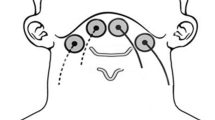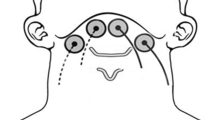Abstract
The impaired swallow timing subsequent to dysphagia or aging can potentially endanger swallowing safety and efficiency. Preliminary evidence has suggested that transcutaneous electrical stimulation (TES) may have the potential to affect swallow timing. However, limited knowledge exists regarding which TES parameters can optimize swallow timing. Pulse frequency is one of the primary TES parameters that can affect the quality of muscle contraction. Yet, no clear information exists regarding how changing pulse frequency impacts the timing of swallowing events. This study aimed to investigate the varying effects of submental TES pulse frequency on swallowing events during and post-15-min TES administration. Twenty-six healthy individuals between the ages of 20 and 54 participated in this study and were assigned to high pulse frequency (HPF) (80 Hz) or low pulse frequency (LPF) (30 Hz) groups. Videofluoroscopic swallowing study (VFSS) was used to record swallowing. Three trials of 10 mL pureed mixed with barium sulfate were presented under three different conditions, including pre-TES, during TES, and post-TES, in which measures were taken following 15 min of TES delivery. The swallow timing events that were measured in each condition were time to maximum hyoid elevation, time to maximum laryngeal elevation, laryngeal vestibule closure reaction time (LVCrt), laryngeal vestibule closure duration (LVCd), time to maximum pharyngeal constriction, and pharyngoesophageal segment (PES) opening duration. No significant pulse frequency effect was found on any swallow timing measures during or after 15 min of TES. Both protocols decreased the duration of some swallowing events during TES including time to maximum hyoid elevation [p < 0.017, ηp2 = 0.185], LVCrt [p < 0.032, ηp2 = 0.158], and time to maximum pharyngeal constriction [p < 0.034, ηp2 = 0.155]. None of the significant TES effects were continued when TES ceased after 15 min. Overall, both protocols have comparable immediate effects on shortening the duration of some swallowing events during TES. Future clinical trials should examine whether these physiologic timing changes can lead to safer and more efficient swallows in patients with dysphagia.




Similar content being viewed by others
Data Availability
The datasets generated during and/or analyzed during the current study are available from the corresponding author on reasonable request.
References
Schiffer BL, Kendall K. Changes in timing of swallow events in Parkinson’s disease. Ann Otol Rhinol Laryngol. 2019;128:22–7.
Prosiegel M, Heintze M, Sonntag EW, Schenk T, Yassouridis A. Kinematic analysis of laryngeal movements in patients with neurogenic dysphagia before and after swallowing rehabilitation. Dysphagia. 2000;15:173–9.
Eisbruch A, Lyden T, Bradford CR, Dawson LA, Haxer MJ, Miller AE, Teknos TN, Chepeha DB, Hogikyan ND, Terrell JE, Wolf GT. Objective assessment of swallowing dysfunction and aspiration after radiation concurrent with chemotherapy for head-and-neck cancer. Int J Radiat Oncol Biol Phys. 2002;53:23–8.
Hamilton VK, Pitts LL, Walaszek EA, Cherney LR. Videofluoroscopic profiles of swallowing and airway protection post-traumatic cervical spinal cord injury. Dysphagia. 2022;37:1599–611.
Mancopes R, Peladeau-Pigeon M, Barrett E, Guran A, Smaoui S, Pasqualoto AS, Steele CM. Quantitative videofluoroscopic analysis of swallowing physiology and function in individuals with chronic obstructive pulmonary disease. J Speech Lang Hear Res. 2020;63:3643–58.
Kendall KA, Leonard RJ. Pharyngeal constriction in elderly dysphagic patients compared with young and elderly nondysphagic controls. Dysphagia. 2001;16:272–8.
Namasivayam-MacDonald AM, Barbon CEA, Steele CM. A review of swallow timing in the elderly. Physiol Behav. 2018;184:12–26.
Schwarz M, Ward EC, Ross J, Semciw A. Impact of thermo-tactile stimulation on the speed and efficiency of swallowing: a systematic review. Int J Lang Commun Disord. 2018;53:675–88.
Dafiah PM, Swapna N. Variations in the amplitude and duration of hyolaryngeal elevation during swallow: effect of sour and carbonated liquid bolus. Physiol Behav. 2020;224:113028.
Barikroo A, Carnaby G, Crary M. Effects of age and bolus volume on velocity of hyolaryngeal excursion in healthy adults. Dysphagia. 2015;30:558–64.
Kendall KA, Leonard RJ, McKenzie SW. Accommodation to changes in bolus viscosity in normal deglutition: a videofluoroscopic study. Ann Otol Rhinol Laryngol. 2001;110:1059–65.
Inamoto Y, Saitoh E, Ito Y, Kagaya H, Aoyagi Y, Shibata S, Ota K, Fujii N, Palmer JB. The Mendelsohn maneuver and its effects on swallowing: kinematic analysis in three dimensions using dynamic area detector CT. Dysphagia. 2018;33:419–30.
McCullough GH, Kamarunas E, Mann GC, Schmidley JW, Robbins JA, Crary MA. Effects of Mendelsohn maneuver on measures of swallowing duration post stroke. Top Stroke Rehabil. 2012;19:234–43.
Molfenter SM, Hsu CY, Lu Y, Lazarus CL. Alterations to swallowing physiology as the result of effortful swallowing in healthy seniors. Dysphagia. 2018;33:380–8.
Hind JA, Nicosia MA, Roecker EB, Carnes ML, Robbins J. Comparison of effortful and noneffortful swallows in healthy middle-aged and older adults. Arch Phys Med Rehabil. 2001;82:1661–5.
Boden K, Hallgren A, Witt Hedstrom H. Effects of three different swallow maneuvers analyzed by videomanometry. Acta Radiol. 2006;47:628–33.
Bisch EM, Logemann JA, Rademaker AW, Kahrilas PJ, Lazarus CL. Pharyngeal effects of bolus volume, viscosity, and temperature in patients with dysphagia resulting from neurologic impairment and in normal subjects. J Speech Hear Res. 1994;37:1041–9.
Bulow M, Olsson R, Ekberg O. Videoradiographic analysis of how carbonated thin liquids and thickened liquids affect the physiology of swallowing in subjects with aspiration on thin liquids. Acta Radiol. 2003;44:366–72.
Logemann JA, Pauloski BR, Colangelo L, Lazarus C, Fujiu M, Kahrilas PJ. Effects of a sour bolus on oropharyngeal swallowing measures in patients with neurogenic dysphagia. J Speech Hear Res. 1995;38:556–63.
Gallas S, Marie JP, Leroi AM, Verin E. Sensory transcutaneous electrical stimulation improves post-stroke dysphagic patients. Dysphagia. 2010;25:291–7.
Barikroo A, McLean MT. Submental transcutaneous electrical stimulation can impact the timing of laryngeal vestibule closure. J Oral Rehabil. 2022;49:817–22.
Watts CR, Dumican MJ. The effect of transcutaneous neuromuscular electrical stimulation on laryngeal vestibule closure timing in swallowing. BMC Ear Nose Throat Disord. 2018;18:5.
Doucet BM, Lam A, Griffin L. Neuromuscular electrical stimulation for skeletal muscle function. Yale J Biol Med. 2012;85:201–15.
Bickel CS, Gregory CM, Dean JC. Motor unit recruitment during neuromuscular electrical stimulation: a critical appraisal. Eur J Appl Physiol. 2011;111:2399–407.
Vinney LA, Connor NP. Structure and function of the laryngeal and pharyngeal muscles. In: McLoon LK, Andrade F, editors. Craniofacial muscles: a new framework for understanding the effector side of craniofacial muscle control. New York: Springer; 2013. p. 141–66.
Faul F, Erdfelder E, Lang AG, Buchner A. G*Power 3: a flexible statistical power analysis program for the social, behavioral, and biomedical sciences. Behav Res Methods. 2007;39:175–91.
Barikroo A, Clark AL. Effects of varying transcutaneous electrical stimulation pulse duration on swallowing kinematics in healthy adults. Dysphagia. 2022;37:277–85.
Crary MA, Mann GD, Groher ME. Initial psychometric assessment of a functional oral intake scale for dysphagia in stroke patients. Arch Phys Med Rehabil. 2005;86:1516–20.
Serel Arslan S, Azola A, Sunday K, Vose A, Plowman E, Tabor L, Singer M, Robison R, Humbert IA. Effects of submental surface electrical stimulation on swallowing kinematics in healthy adults: an error-based learning paradigm. Am J Speech Lang Pathol. 2018;27:1375–84.
Cichero JA, Lam P, Steele CM, Hanson B, Chen J, Dantas RO, Duivestein J, Kayashita J, Lecko C, Murray J, Pillay M, Riquelme L, Stanschus S. Development of international terminology and definitions for texture-modified foods and thickened fluids used in dysphagia management: the IDDSI framework. Dysphagia. 2017;32:293–314.
Miklavcic D, Pucihar G, Pavlovec M, Ribaric S, Mali M, Macek-Lebar A, Petkovsek M, Nastran J, Kranjc S, Cemazar M, Sersa G. The effect of high frequency electric pulses on muscle contractions and antitumor efficiency in vivo for a potential use in clinical electrochemotherapy. Bioelectrochemistry. 2005;65:121–8.
Humbert IA. Point/counterpoint: electrical stimulation for dysphagia: the argument against electrical stimulation for dysphagia. Persp Swallow Swallow Disord (Dysphagia). 2011;20:102–8.
Kendall KA, Leonard RJ. Hyoid movement during swallowing in older patients with dysphagia. Arch Otolaryngol Head Neck Surg. 2001;127:1224–9.
Guedes R, Azola A, Macrae P, Sunday K, Mejia V, Vose A, Humbert IA. Examination of swallowing maneuver training and transfer of practiced behaviors to laryngeal vestibule kinematics in functional swallowing of healthy adults. Physiol Behav. 2017;174:155–61.
Steele CM, Peladeau-Pigeon M, Barbon CAE, Guida BT, Namasivayam-MacDonald AM, Nascimento WV, Smaoui S, Tapson MS, Valenzano TJ, Waito AA, Wolkin TS. Reference values for healthy swallowing across the range from thin to extremely thick liquids. J Speech Lang Hear Res. 2019;62:1338–63.
Park T, Kim Y, Ko DH, McCullough G. Initiation and duration of laryngeal closure during the pharyngeal swallow in post-stroke patients. Dysphagia. 2010;25:177–82.
Kahrilas PJ, Lin SZ, Rademaker AW, Logemann JA. Impaired deglutitive airway protection: a videofluoroscopic analysis of severity and mechanism. Gastroenterology. 1997;113:1457–64.
Heck FM, Doeltgen SH, Huckabee ML. Effects of submental neuromuscular electrical stimulation on pharyngeal pressure generation. Arch Phys Med Rehabil. 2012;93:2000–7.
Jungheim M, Janhsen AM, Miller S, Ptok M. Impact of neuromuscular electrical stimulation on upper esophageal sphincter dynamics: a high-resolution manometry study. Ann Otol Rhinol Laryngol. 2015;124:5–12.
Berretin-Felix G, Sia I, Barikroo A, Carnaby GD, Crary MA. Immediate effects of transcutaneous electrical stimulation on physiological swallowing effort in older versus young adults. Gerodontology. 2016;33:348–55.
Barikroo A, Berretin-Felix G, Carnaby G, Crary M. Effect of transcutaneous electrical stimulation amplitude on timing of swallow pressure peaks between healthy young and older adults. Gerodontology. 2017;34:24–32.
Brates D, Molfenter S. The influence of age, eating a meal, and systematic fatigue on swallowing and mealtime parameters. Dysphagia. 2021;36:1096–109.
Kays SA, Hind JA, Gangnon RE, Robbins J. Effects of dining on tongue endurance and swallowing-related outcomes. J Speech Lang Hear Res. 2010;53:898–907.
Hiramatsu T, Kataoka H, Osaki M, Hagino H. Effect of aging on oral and swallowing function after meal consumption. Clin Interv Aging. 2015;10:229–35.
Brates D, Troche M, Molfenter S. The role of fatigue in the aging swallow: a review. OBM Geriatr. 2021;05:166.
Matsuo K, Palmer JB. Coordination of mastication, swallowing and breathing. Jpn Dent Sci Rev. 2009;45:31–40.
Watts CR, Dumican MJ. The effect of transcutaneous neuromuscular electrical stimulation on laryngeal vestibule closure timing in swallowing. BMC Ear Nose Throat Disord. 2018;18:1–7.
Jungheim M, Schubert C, Miller S, Ptok M. Swallowing function after continuous neuromuscular electrical stimulation of the submandibular region evaluated by high-resolution manometry. Dysphagia. 2017;32:501–8.
Barikroo A, Carnaby G, Bolser D, Rozensky R, Crary M. Transcutaneous electrical stimulation on the anterior neck region: the impact of pulse duration and frequency on maximum amplitude tolerance and perceived discomfort. J Oral Rehabil. 2018;45:436–41.
Molfenter SM, Steele CM. Variation in temporal measures of swallowing: sex and volume effects. Dysphagia. 2013;28:226–33.
Smaoui S, Mancopes R, Simmons MM, Peladeau-Pigeon M, Steele CM. The influence of sex, age, and repeated measurement on pixel-based measures of pharyngeal area at rest. J Speech Lang Hear Res. 2023;66:863–71.
Doan TN, Ho WC, Wang LH, Chang FC, Tran TTQ, Chou LW. Therapeutic effect and optimal electrode placement of transcutaneous neuromuscular electrical stimulation in patients with post-stroke dysphagia: a systematic review and meta-analysis of randomized controlled trials. Life (Basel). 2022;12:875.
Funding
This study was supported by start-up funding from Kent State University to PI Ali Barikroo.
Author information
Authors and Affiliations
Corresponding author
Ethics declarations
Conflict of interest
The authors declare that they have no conflict of interest.
Ethical Approval
All procedures performed in studies involving human participants were in accordance with the ethical standards of the institutional and/or national research committee and with the 1964 Helsinki declaration and its later amendments or comparable ethical standards.
Informed Consent
Informed consent was obtained from all individual participants included in the study.
Additional information
Publisher's Note
Springer Nature remains neutral with regard to jurisdictional claims in published maps and institutional affiliations.
Rights and permissions
Springer Nature or its licensor (e.g. a society or other partner) holds exclusive rights to this article under a publishing agreement with the author(s) or other rightsholder(s); author self-archiving of the accepted manuscript version of this article is solely governed by the terms of such publishing agreement and applicable law.
About this article
Cite this article
Barikroo, A., Zinser, A. Impact of Varying Transcutaneous Electrical Stimulation Pulse Frequency on Swallow Timing Measures in Healthy Adults. Dysphagia 39, 140–149 (2024). https://doi.org/10.1007/s00455-023-10601-1
Received:
Accepted:
Published:
Issue Date:
DOI: https://doi.org/10.1007/s00455-023-10601-1




